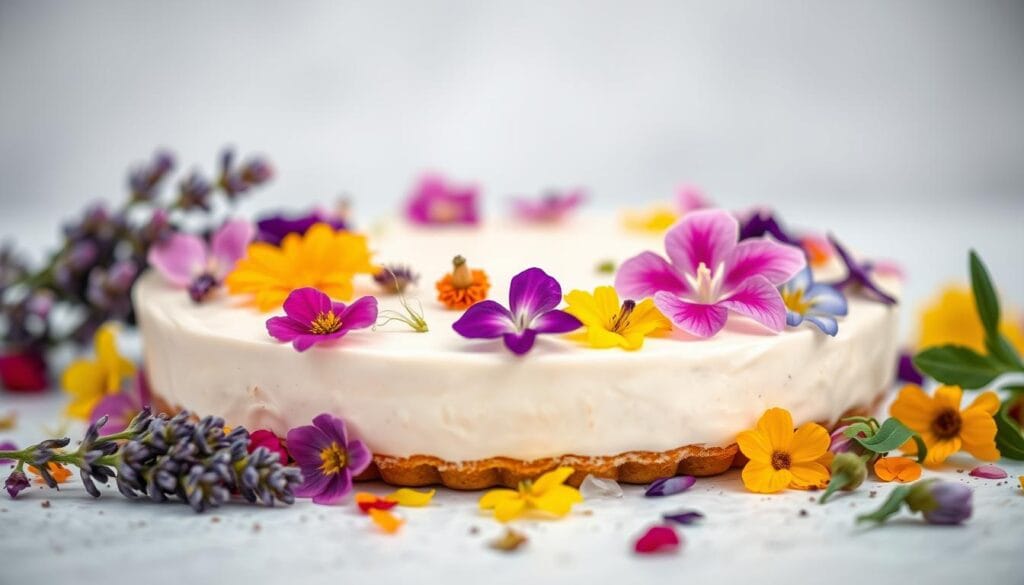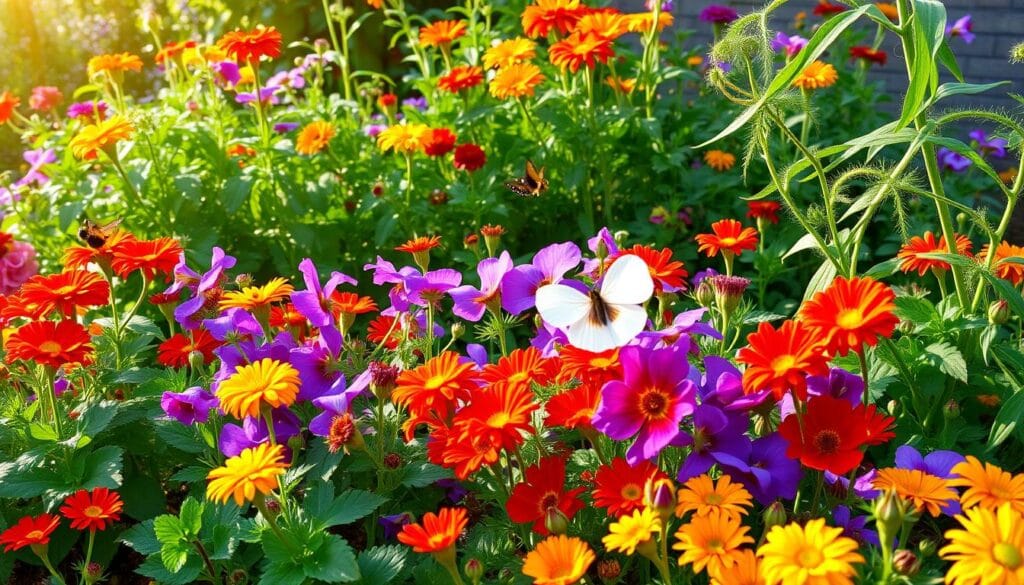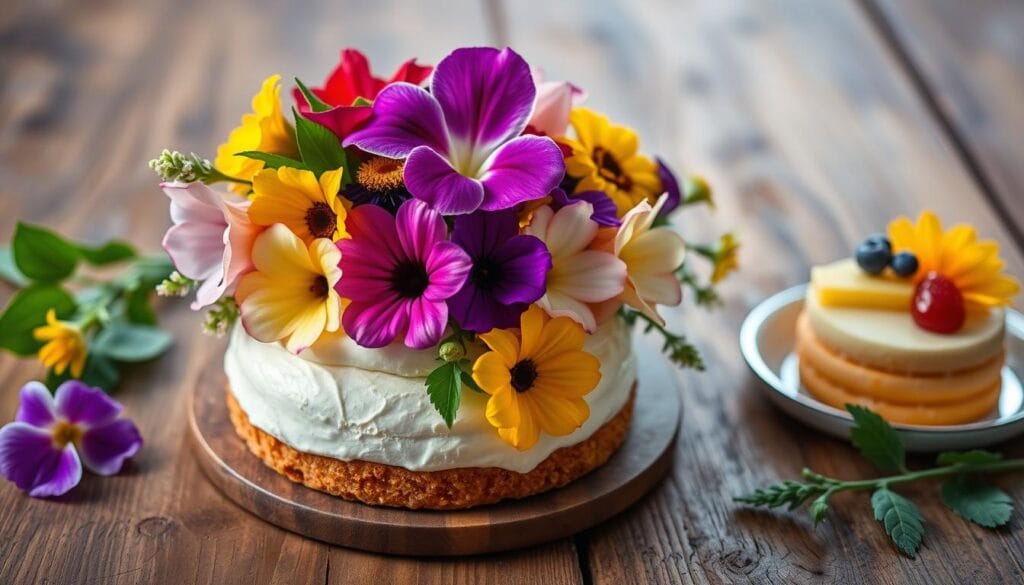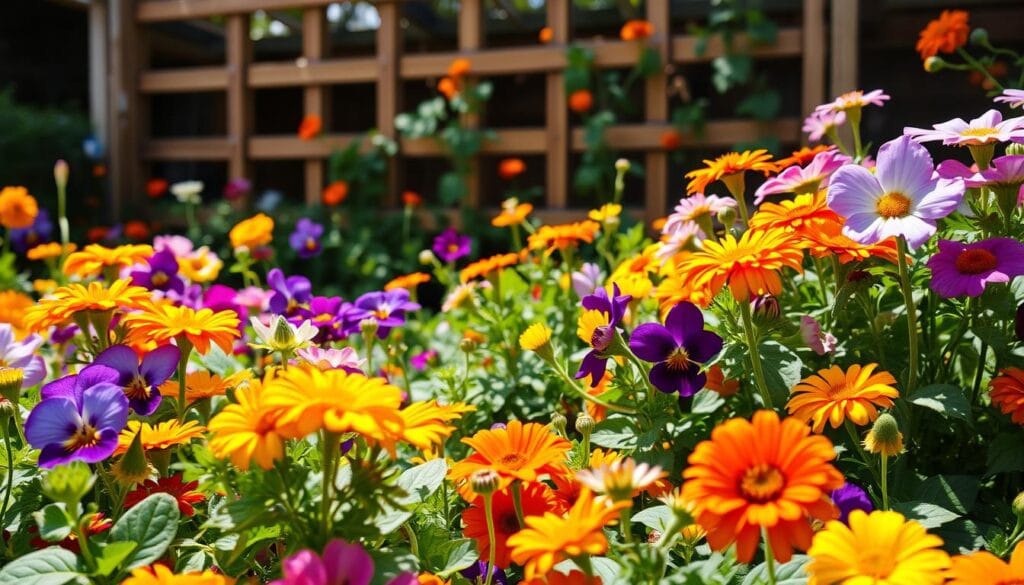Imagine adding a pop of color and unique flavors to your meals with edible flowers. You can use culinary flowers like pansies, roses, and lavender to elevate your dishes from ordinary to extraordinary. Edible blossoms can be used in salads, desserts, and even as a garnish for cocktails, making cooking with edible flowers a great way to add beauty and flavor to your meals.
With a wide range of flavors and colors, edible blossoms can enhance any meal. You can use edible flowers like marigolds, calendula, and dandelions to add a mild citrus flavor or a slightly sweet flavor to your dishes. Cooking with edible flowers is a great way to experiment with new flavors and recipes.
Key Takeaways
- You can use edible flowers like pansies, roses, and lavender to add beauty and flavor to your dishes.
- Culinary flowers can be used in salads, desserts, and as a garnish for cocktails.
- Edible flowers like marigolds, calendula, and dandelions can add a mild citrus flavor or a slightly sweet flavor to your meals.
- Cooking with edible flowers is a great way to experiment with new flavors and recipes.
- Edible flowers can be used to make your dishes more visually appealing and delicious.
- You can grow your edible flowers or purchase them at nurseries, farmer’s markets, and grocery stores.
Introduction to Edible Flowers
Edible flowers have been a part of cooking for thousands of years. Ancient Greeks and Romans used them in their meals. You can find many Edible flower recipes to make your dishes special. It’s important to know the Edible Flowers list to pick the safe and right options.
Roses, violets, lavender, and nasturtiums are popular edible blossoms. They add unique tastes and smells to your food. For example, nasturtiums and basil blossoms can make microgreen salads better. You can also use roses and marigolds to decorate birthday cakes.
When using edible flowers in cooking, remember about plant allergies. Make sure you know what you’re eating. Harvest flowers in the morning for the best color. And, never use flowers that have been sprayed with pesticides or chemicals.
Here are some tips for using flower-based delicacies in your cooking:
- Use edible blossoms as toppings for light, cool dishes
- Mix them into baked goods to bring out their delicate flavors
- Infuse punch with elderflowers and hibiscus petals for a unique flavor
- Add fresh pansies to spring rolls for a pop of color and flavor
Types of Edible Flowers
There are many edible blossoms to pick from for your cooking. Pansies and violets are great for salads, adding flavor and color. Roses and lavender are perfect for desserts, offering a sweet taste.
Some popular edible blossom varieties include:
- Pansies, with their sweet, grassy flavor
- Violets, with their sweet, floral flavor
- Roses, with their delicate, slightly sweet flavor
- Lavender, with its floral and slightly bitter flavor
There are many more floral ingredients for cooking. Nasturtiums taste like capers and are great in salads. Chamomile flowers are perfect for tea or desserts, adding a calming touch.

It’s key to know when each flower is in season. This helps plan your recipes better. Using floral ingredients can make your dishes more flavorful and creative.
| Edible Flower | Flavor | Use in Cooking |
|---|---|---|
| Pansies | Sweet, grassy | Salads, desserts |
| Violets | Sweet, floral | Desserts, garnish |
| Roses | Delicate, slightly sweet | Salads, desserts |
| Lavender | Floral, slightly bitter | Desserts, teas |
Nutritional Benefits of Edible Flowers
Creating an edible flower garden means thinking about the health benefits of the flowers. Many floral ingredients are packed with vitamins and minerals. For instance, chrysanthemums can help with headaches and boost your digestive and nervous systems.
Using these flowers in cooking adds flavor and nutrition to your meals. Dandelions, for example, are full of vitamin A, which is good for your eyes and immune system. Lavender can be used in baked goods and salads, giving them a light citrus taste.
Here are some key health benefits of floral ingredients:
- They are rich in vitamins and minerals, like vitamin C and potassium.
- They have antioxidant properties, which protect cells and reduce inflammation.
- They also have anti-inflammatory properties, helping to prevent chronic diseases.

Adding floral ingredients to your diet can make meals more interesting and nutritious. Whether you’re growing an edible flower garden or just want to try new recipes, there are many options. Edible blossoms bring unique flavors and health benefits to any dish.
| Flower-Based Delicacies | Nutritional Benefit |
|---|---|
| Dandelion | High in vitamin A |
| Lavender | Anti-inflammatory properties |
| Chrysanthemum | Treats headaches and improves digestive health |
Culinary Uses for Edible Flowers
Flower-based delicacies can make your dishes stand out. They add color and flavor to salads and desserts. For example, nasturtiums and pansies are great for salads. Roses and lavender are perfect for desserts.
Popular edible blossoms include violas, roses, and lavender. They bring color, flavor, and beauty to your meals. You can make sugared flowers or candied flowers to decorate your desserts.
Here are some examples of dishes that use flower-based delicacies:
- Salads with floral ingredients like nasturtium and pansies
- Desserts like cakes, cupcakes, and cookies with floral ingredients like roses and lavender
- Drinks like teas and cocktails with edible flowers like hibiscus and rose petals
These flowers can be used in many recipes. They can be added to buttermilk pancakes, cakes, and syrups. They can also be used as a garnish or mixed into the batter for extra flavor and texture. With a little creativity, you can make beautiful and delicious dishes that will wow your friends and family.

| Floral Ingredients | Culinary Use |
|---|---|
| Roses | Desserts, salads, and drinks |
| Lavender | Desserts, teas, and cocktails |
| Nasturtium | Salads and savory dishes |
How to Grow Edible Flowers
Starting an edible flower garden is both fun and rewarding. With the right care, edible flowers can flourish in your garden. First, pick the best flowers for your garden. Calendula, sunflowers, and nasturtiums are great choices.
Think about what each flower needs to grow well. Calendula likes partial shade and grows 10-12 inches tall. Sunflowers, being a dwarf variety, only reach 2-3 feet. China aster, however, needs full sun and can grow up to 3 feet tall.
Here are some easy-to-grow edible flowers for your garden:
- Calendula
- Sunflowers
- Nasturtiums
- Violas
- Pansies
Make sure to research each flower’s specific needs. This way, your edible flower garden will be both beautiful and delicious.

| Flower | Growing Conditions | Height |
|---|---|---|
| Calendula | Partial shade | 10-12 inches |
| Sunflowers | Full sun | 2-3 feet |
| China Aster | Full sun | 3 feet |
Foraging for Edible Flowers
Exploring edible flowers can be a fun and rewarding journey. It’s crucial to focus on safety and knowledge when foraging. Make sure to identify flowers correctly, as some can be harmful. For example, pansies and marigolds are safe for salads and add flavor and color.
Before you start foraging, keep these tips in mind:
- Choose non-toxic flowers from unfertilized areas
- Understand the energy and consciousness of flowers
- Practice responsible harvesting methods
These guidelines ensure a safe and enjoyable foraging experience. Edible flowers like roses and violets are perfect for desserts, making them both beautiful and tasty.
Some popular edible flowers to forage include:
- Dandelions, identifiable by their cheerful bloom and toothy foliage
- Blackberries, easy to identify in summer by their thorny stems and pristine white flowers
- Violets, commonly found in shaded lawns or fields in early spring
Always prioritize your safety and the environment’s well-being when foraging.
By following these guidelines and being aware of your surroundings, you can enjoy foraging. Edible flowers can enhance your cooking, whether in salads, desserts, or other dishes.
| Edible Flower | Culinary Use |
|---|---|
| Pansies | Salad toppings, baked goods |
| Marigolds | Sautéing, pickling |
| Roses | Desserts, teas |
Preparing Edible Flowers for Cooking
When you’re ready to cook with edible flowers, cleaning and handling them right is key. Rinse them gently with water and then dry them with a paper towel. This removes dirt and keeps them fresh.
Edible flowers can make your dishes more colorful and tasty. You can use them in everything from salads to desserts. Popular choices include Marigolds, Violas, and Dianthus. Try them in dishes like Spring Pavlova, Strawberry and Goat Cheese Crostini, and Focaccia bread.
Proper Cleaning Techniques
To clean edible flowers, start by rinsing them with cold water. This gets rid of dirt and debris. Then, dry them with a paper towel to prevent bacteria growth.
Creative Ways to Use Edible Flowers
Edible flowers can be used in many creative ways. They’re great as garnishes for drinks, like adding Marigolds to a Tinto de Verano. They also make amazing desserts, like cakes, cookies, and ice cream. Violets, Hibiscus, and Geraniums are favorites for desserts.
- Use edible flowers to add color and flavor to salads and other dishes.
- Make a variety of desserts using edible flowers, such as cakes, cookies, and ice cream.
- Use edible flowers as a garnish for cocktails and other beverages.
By using these tips, you can bring creativity and flavor to your cooking. Edible flowers are perfect for adding color and taste to any dish, from simple salads to complex desserts.
Edible Flowers Around the World
Exploring edible flowers opens up a world of flavors and textures. From delicate violets to vibrant nasturtiums, each flower adds something special to your dishes. When making your Edible flowers list, think about their cultural importance worldwide.
In many places, edible flowers are key to traditional dishes. For instance, in Italy, squash blossoms are a favorite. In India, rose petals are used in desserts like gulab jamun. Plan your garden with the flowers you want to use in your cooking.
Here are some popular edible flowers from around the world:
- Nasturtiums, with their peppery flavor and delicate texture
- Calendula, also known as pot marigold, with its bright orange and yellow petals
- Lavender, with its sweet, floral flavor and fragrance
When exploring edible flowers, always prioritize safety and sustainability. Choose varieties free from pesticides and be aware of allergies. With creativity and experimentation, you can create a beautiful Edible flower garden. Enjoy the flavors and beauty of these incredible flowers.
| Flower | Flavor | Texture |
|---|---|---|
| Nasturtium | Peppery | Delicate |
| Calendula | Mild, sweet | Soft |
| Lavender | Sweet, floral | Fragrant |
Pairing Edible Flowers with Other Ingredients
Using edible flowers in your cooking can make your dishes taste better and look great. For desserts, like rose petals or lavender, add a special touch. For salads, nasturtiums or borage bring freshness and color.
Flavor Profiles of Popular Edible Flowers
Knowing the flavors of popular edible flowers helps you pair them right. Lavender tastes floral and sweet. Nasturtiums are peppery and spicy. Borage flowers taste like honey, perfect for salads and drinks.
Suggestions for Pairings
Here are some pairing ideas:
- Pansies with mint or basil for a fresh salad
- Rose petals with dark chocolate for a rich dessert
- Nasturtiums with oranges or lemons for a zesty flavor
Try different pairings to make unique and tasty dishes. Whether for desserts or salads, the fun is in being creative.
Storing Edible Flowers
To keep your edible flower garden fresh, proper storage is key. When you have an edible flowers list, you want to enjoy them for as long as you can. Storing edible flowers requires careful handling to keep their delicate flavor and texture.
One great way to store edible flowers is in the refrigerator. This keeps them fresh for a longer time. You can also freeze or dry them for later use. Freezing in ice cubes can keep them fresh for up to a year. Drying preserves their color and flavor.
Best Practices for Preservation
Some edible flowers can be preserved in syrups or cordials. For example, elderflower syrup is made with ten elderflower heads per cup of water. Violet syrup is made with three cups of sweet violet flowers per cup of water. These syrups add flavor to various dishes and drinks.
Signs of Spoilage
It’s important to regularly check your edible flowers for spoilage. If you see wilting, browning, or mold, throw them away. Proper storage and handling prevent spoilage and keep flowers fresh longer.
By following these tips, you can enjoy your edible flower garden and list for longer. Whether in cooking, as a garnish, or in arrangements, proper storage and handling are key. They help maintain freshness and flavor.
Conclusion: Elevating Your Dishes with Edible Flowers
Edible flowers can turn simple dishes into amazing culinary works. They can make a salad pop with pansies or add sweetness to desserts with lavender. These colorful blooms can make your food stand out.
Final Thoughts on Using Edible Flowers
Let your creativity run wild with edible flowers. Try different types to find their unique tastes and textures. Just make sure to check if they’re safe to eat before using them in your cooking.
Encouraging Creativity in the Kitchen
Edible flowers are like a treasure trove of possibilities. Use them to add flair to or to give a fresh twist. With a bit of creativity, you can make your dishes truly special.
FAQ
What are edible flowers?
Edible flowers are safe for people to eat and can be used in cooking. They’ve been used for centuries in many cuisines, like Asian and European.
What types of edible flowers are there?
There are many edible flowers, each with its own taste and feel. Popular ones include pansies, violets, and roses.
What are the nutritional benefits of edible flowers?
Edible flowers are full of vitamins, minerals, and antioxidants. These can help protect cells and reduce inflammation.
How can edible flowers be used in cooking?
Edible flowers can spice up many dishes, from savory to sweet. They can add flavor and texture to salads, desserts, and even drinks like teas and cocktails.
How can I grow edible flowers at home?
Growing edible flowers at home is rewarding. With the right care, they can grow well in your garden. Consider soil, sunlight, and water needs.
How do I safely forage for edible flowers?
Foraging for edible flowers needs caution and knowledge. It’s crucial to know which flowers are safe. Always follow safety tips, like avoiding polluted areas.
How should edible flowers be prepared for cooking?
To cook with edible flowers, clean and handle them properly. Gently wash and dry them before use. Store them in the fridge to keep them fresh.
What are some unique ways to use edible flowers in cooking?
You can use edible flowers in many creative ways. Try them in savory dishes or as a garnish for sweets. Experimenting with flavors can lead to tasty and beautiful dishes.
How should edible flowers be stored for later use?
To keep edible flowers fresh, store them right. You can refrigerate, freeze, or dry them. Always check for spoilage to stay safe.
Source Links
- How To Use Edible Flowers With Molly J. Wilk — HALDEN – https://haldengarden.com/blog/edibleflowers?srsltid=AfmBOopLh3F9_1EkHtoA2Np1DLip52qlK6ru9iSaNQ_6JZ4aOFaNjeH3
- Edible Flowers – How to Add a Splash of Beautiful Pizzazz to Any Meal! – https://thecafesucrefarine.com/edible-flowers-how-to-add-a-splash-of-beautiful-pizzazz-to-any-meal/
- 12 Edible Flowers That Are Our New Favorite Garnish for Everything – https://www.tasteofhome.com/collection/edible-flowers/?srsltid=AfmBOor5fvDDYfP3MTtDvkXHl2VfoyzPzRDumNRmvwVD6HuYXVct2KEZ
- The Best Edible Flowers for Cakes, Cocktails & More | Sur La Table – Lid & Ladle – https://learn.surlatable.com/what-are-edible-flowers/
- Flowers You Can Eat – https://kids.frontiersin.org/articles/10.3389/frym.2024.1403243
- 10 edible flowers and how to use them – https://www.finedininglovers.com/explore/articles/10-edible-flowers-and-how-use-them
- Edible Flowers: Flowers You Can Eat (AND how to use them) — Food Garden Life: Edible Garden, Vegetable Garden, Edible Landscaping – https://www.foodgardenlife.com/learn/edible-flowers
- What Flowers Are Edible? – https://www.webstaurantstore.com/blog/3616/what-flowers-are-edible.html?srsltid=AfmBOopsf5WiSBH4QqYVMRM77lMRvo67oaH0OmUiBnY-gH7E845L5ytA
- WSMAG.NET | These 10 Edible Flowers Are Beneficial for Your Health | Blog, Featured, Gardeners Corner | August 21, 2024 | WestSound Magazine – https://wsmag.net/blog/gardeners-corner/2024-08-21/these-10-edible-flowers-are-beneficial-for-your-health/
- 5 Edible Flowers With Potential Gut Health Perks & How To Use Them – https://www.mindbodygreen.com/articles/5-edible-flowers-with-potential-gut-friendly-perks-how-to-use?srsltid=AfmBOop5RHzr5SSpS2c6iGKR0Ygwhl-J-qBHClfE1tQy3RnmNUEviEQG
- Our Favorite Edible Flower Recipes That Are Colorful & Delicious – https://www.marthastewart.com/edible-flower-recipes-7503243
- How to Cook With Edible Flowers – https://savannahbee.com/blogs/the-latest-buzz/how-to-cook-with-edible-flowers?srsltid=AfmBOoqKtU0hozivtgbw9mxKmMRszSdE8TpkvO_2ZpPHQ1Wmkcw5hejq
- Unlocking the Culinary Potential of Your Garden With Edible Flowers – https://thecottagepeach.com/blog/edible-flowers-you-can-grow-in-your-garden
- Growing Edible Flowers in Your Garden – https://www.almanac.com/growing-edible-flowers-your-garden
- Edible Flowers ~ Edible Consciousness — Karin Edgett – https://www.karinedgett.art/art-food-etc-blog/2024/4/5/edible-flowers-edible-conscoiusness
- Foraging Flowers: How To Forage Floral Plants – And Which Flowers You Can Pick For Free Edibles! – https://www.gardeningknowhow.com/ornamental/flowers/foraging-flowers
- How to Cook With Edible Flowers – https://savannahbee.com/blogs/the-latest-buzz/how-to-cook-with-edible-flowers?srsltid=AfmBOookR2Y4UypDtaatj_YSXaMKJ1objvWs_18XUMhnCQHWh_SG6Jwt
- How To Use Edible Flowers With Molly J. Wilk — HALDEN – https://haldengarden.com/blog/edibleflowers?srsltid=AfmBOorFgRfGKF1QtfPQYP7ZO5HliLUgBMIGViDkORBXazd_UuPpS-W5
- How To Prepare Edible Flowers: A Guide – https://slowlivingkitchen.com/edible-flowers/
- Did You Know You Can Grow These Edible Flowers in Your Garden? – https://www.thepioneerwoman.com/home-lifestyle/gardening/g32723510/edible-flowers/
- Nature’s Hidden Gems: 15 Edible Flowers to Enliven Your Cooking – https://oishya.com/journal/natures-hidden-gems-15-edible-flowers-to-enliven-your-cooking/
- Edible Flowers: A Journey Through History to Your Garden – https://www.thecelticfarm.com/edible-flowers/
- What Flowers Are Edible? – https://www.webstaurantstore.com/blog/3616/what-flowers-are-edible.html?srsltid=AfmBOopyQAaKhhDkFIO38r_DnRzKai6XqY6VtY3ambtqj5bU4DSlGBbx
- Exploring the World of Edible Flowers: A Culinary Adventure – Setorii – https://setorii.com/exploring-the-world-of-edible-flowers/
- 19 Edible Flowers for Your Garden – https://www.epicgardening.com/edible-flowers/
- Four Ways to Preserve Edible Flowers • Lovely Greens – https://lovelygreens.com/edible-flowers-crystallizing-primroses/
- How to use, preserve, and enjoy edible flowers – https://www.rhs.org.uk/garden-inspiration/floristry/how-to-use-edible-flowers
- The Art of Edible Flowers: Enhancing Culinary Creations with Nature’s Blooms – https://sweetbotanicalbakes.com/blogs/news/the-art-of-edible-flowers-enhancing-culinary-creations-with-nature-s-blooms
- Ultimate Guide to Edible Flowers for Cocktails – https://www.moodymixologist.com/blog/cocktailians-guide-to-edible-flowers
- Blossoming Trends: The Rising Popularity of Edible Flowers in Baking and Seasoning – https://www.linkedin.com/pulse/blossoming-trends-rising-popularity-edible-flowers-baking-3meyf
- The Ultimate Guide to Planting Roses in Clay Soil – https://www.blossomgardenshub.com/planting-roses-in-clay-soil/
- Flowers That Attract Pollinators




